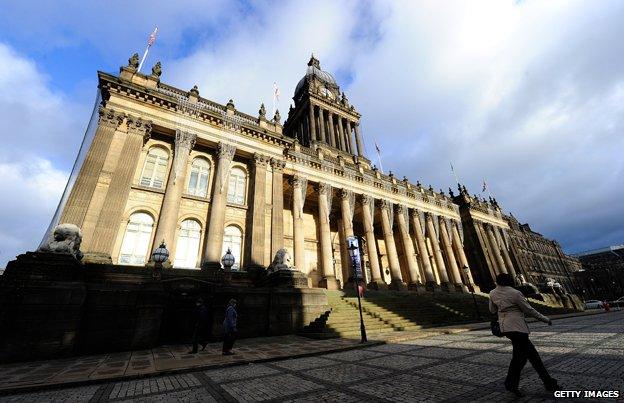Whitehall v town hall
- Published
- comments

The swirling wind of anti-politics that has swept across the Westminster parliament in recent times stems from a conviction that the politicians sitting on warm green leather in the House of Commons are oblivious to the harsh realities of ordinary life.
It is that sense of a London elite, out of touch with the real world, that has encouraged politicians of all stripes to talk of the importance of localism.
David Cameron came to power promising to give local councils much more power. "Over the last century Britain has become one of the most centralised countries in the developed world," he said. "I am convinced that if we have more local discretion - more decisions made and money spent at the local level - we'll get better outcomes."
But in the spring of 2011, something counter-intuitive happened. For the first time probably in living memory, central government was bigger than local government. The number of people in the UK employed by Whitehall overtook the number employed by the town hall.
Back in 1963, the earliest year for which I have found figures, local councils employed about two million people, 200,000 more than Whitehall. Ten years later, and the local authority workforce was close to three million and almost 900,000 greater than central government.
Today, though, the situation has almost completely reversed, with half a million more people on the national payroll than the local one. Indeed, the number employed by local authorities has fallen more than half a million since the last election.
In many towns and cities, the council was once the biggest employer by far. Nowadays, that's much less likely to be true and may be changing the relationship between local people and the local authority. Councils have become more of a service commissioner than the heartbeat of the local economy.
The reasons for this change are varied. Contracting services out to private providers explains some of the fall in council staff numbers. The jobs are still there, for the most part, but the people are no longer employed by the state.
Some services are no longer offered by local authorities and are either provided by volunteers or have disappeared altogether.
One significant effect has been local-authority-maintained schools converting to academy status. In the past year, 53,000 teachers and other school staff switched from the local government headcount to central government control. The creation of English sixth form college corporations also saw 20,000 "council staff" reclassified as private sector workers.
On the other hand, the reclassification of English FE colleges has seen 176,000 workers move from central government to the private sector - so explaining the widening gap between central and local government headcounts must go beyond education.

NHS expansion has been a factor in driving up the number of those employed by central government
One big factor is the expansion of the health service. The number of NHS workers - the majority of whom are employed centrally - has gone up from 1.2 million in 1999 to over 1.5 million now. But we've also seen the privatisation of the Royal Mail and the "re-privatisation" of Lloyds Banking Group taking central government workers into the private sector.
Does this matter? On the day councils reflect on the impact of further reductions in the grant they receive from central government, perhaps we might also reflect on the changing nature of local authorities.
The prime minister is a critic of "big government" and yet the number of people employed by Whitehall has rarely been higher than it is today - 2.9 million people. In 1963 it was nearer 1.8 million.